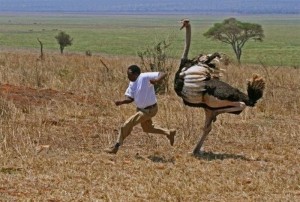Imagine for a moment that you happen to live in a Dr. Seuss-style world. Having just graduated from your local institute of educational hobnobbery, you find yourself hired into a lucrative new position: you’re a whatsitdoer. The job description is self-explanatory: it’s your job to examine a series of curious-looking objects and figure out what it is they were designed to do; what their function happens to be. On your first day at work, a shiny metal box comes down the conveyer belt. You begin to examine the object for evidence of special design. That is, does the object appear to be improbably well-designed for a solving various aspects of a particular task with efficiency? You note that the black cord ending in metal prongs running out of the box might suggest that it runs on electricity, the two slots at the top of the box appear to be shaped appropriately so as it fit bread rather well, and there appears to be a heating apparatus within the box. You test each design feature according: the device only functions when plugged it, bread does indeed fit well in the box, and is evenly toasted by the heating element. Importantly, larger items don’t seem to fit in well, smaller items fall in, becoming unreachable, and non-bread items, like CDs tend to melt or catch fire. In other words, the function of this tool appears as if it were designed to use a relatively narrow set of inputs to produce a useful output – toast.
When you report the results of your tests to your boss, however, he’s not at all pleased with you analysis: “How can you possibly say that this object is designed to make toast when you haven’t recreated the steps of its manufacturing process? Until you have examined the history of how this object has come to be, how the material it is made out of was gathered and shaped, as well as what earlier prototypes of the model might have looked like extending back thousands of years, I can’t accept your suggestion, as you haven’t tested your functional explanation at all!” Now this all strikes you as very strange: you haven’t made any claims about how the object was developed or what earlier versions looked like; you made a claim about how the contemporary object you were given likely functions. As such, understanding the history of the object, while perhaps a neat piece of information that might inform later research on function, is not by any means a requirement for understanding an object’s function. In other words, you should be able to persuade your boss that the toaster is pretty good at making toast without having to give him a complete history of the thing.
Sure; it’s possible that the toaster-like object actually wasn’t designed to make toast at all; toast just happens to be a pretty convenient byproduct of another function it was designed to carry out. However, if we were deriving predictions about what that alternative function was, we still shouldn’t need the history lesson to do that. It’s not that the history information would be necessarily useless: for instance, if you knew the device existed before bread was a thing, then toasting bread certainly couldn’t have been its initial function (though it may well have been co-opted for that function when bread – or pop tarts – became a thing). However, if toasters are well-suited for other functions, you should be able to demonstrate those other functions with design evidence. History is useful insomuch as it helps inform us about what design evidence to look for, certainly, but does not itself inform us as to functionality.
That said, there have been suggestions that phylogenetic analyzes (examinations of the branching of evolutionary tree) can help inform us as to whether a trait is functional (i.e. an adaptation) or not. Specifically, Fraley, Brumbaugh, & Marks (2005) wrote that, “In order to evaluate the adaptive nature of the relationship between traits, it is necessary to account for phylogenetic relationships among species” (p.733, emphasis mine). The authors go on to note, correctly, that species may be similar to one another because of a shared evolutionary history: rather than all the ape species evolving eyes independently, a common ancestor to all of them might well have had eyes and, because we share that ancestor, we all have eyes as well. Now, as you should be careful to note, this is a claim about the evolutionary history of the trait: whether it was independently evolved multiple times in different lineages, or whether it was evolved once and then maintained into subsequent generations. You should note, however, that this is not a functional claim: it doesn’t tell us what eyes do, what inputs they use, what outputs they generate, and so on. Some examples should make this distinction quite clear.
Let’s consider, as an example, two species of birds: the ostrich and any variety of parrot you’d prefer. In the interests of full disclosure, I don’t know how recently the two species shared a common ancestor, but at some point we can say they did. Further, for the sake of argument, let’s say that this common ancestor between ostriches and parrots had feathers. The fact that both ostriches and parrots have feathers, then, can be said to be the result of homology (i.e. shared ancestry). However, this does not tell us anything about what the function(s) of these feathers are in their respective species, nor what selective pressures are responsible for their initial appear or maintenance across time. For instance, parrots are capable of flight while ostriches are not. We might expect that parrot feathers show some adaptations for that function, whereas such adaptive designs might have been degraded or lost entirely in ostriches (presuming the common ancestor flew, that is). However, the feathers might also serve other, identical functions in both species: perhaps feathers are also used to keep both species warm, or are advertised during sexual displays. Whatever the respective functions (or lack thereof) of these feathers in different species, we are unable to deduce that function from a phylogenetic analysis alone. What we need are considerations of what adaptive tasks the feathers might serve, and what design evidence we might expect to find because of that.
Fraley et al (2005) go on to suggest that if two traits repeatedly evolve together across species, these, “…correlation[s] between the traits…strongly suggests a functional relationship” (p. 734, emphasis mine). Again, the claim being made is that we can go from history – the two traits tend to show up together – to function. On top of the problems outlined above, such a statement runs into another large obstacle: non-functional or maladaptive byproducts of traits should be expected to correlate as well as adaptive ones. Let’s start with a non-functional example: imagine that placental mammals evolved multiple times over the course of history. If you were examining many different species, you’d probably see a good correlation between the evolution of placentas and presence of belly-buttons. However, the correlation between these two traits doesn’t tell you anything at all about the function (or lack thereof) of either placentas or belly-buttons. In another case, you might notice that there’s a pretty decent correlation between animals with a taste for sugar and the development of cavities in their teeth, but this in no way implies that a preference for sugar has any functional relationship with cavities; bacteria dissolving your teeth generally has poor fitness outcomes, and wouldn’t be selected for.
One final example might help make the point crystal clear: human male investment in children. Let’s say you have two males displaying the same behavior: buying food for their child. That’s awfully charitable of them. However, in one case, the man is the genetic father of the child, whereas the other male is only the child’s stepfather. These behaviors, while ostensible similar, might actually be serving distinct functions. In the case of the genetic father, the investment in that child might involve mechanisms designed for kin-directed altruism (i.e. investing in the child because the child carries some of his genes) and/or mechanisms designed for mating effort (i.e. investing in the child as a means of increasing sexual access to the mother). In contrast, we might expect the stepfather to be investing for the latter reason, but not the former. In other words, we have the same behavior – investing in children – being driven by two very different functional mechanisms. The predictions that can be drawn from these alternative functions are testable even without any reference at all to history or phylogeny: as it turns out, genetic fathers living with the mother invest more than genetic fathers not living with the mother, but genetic fathers continue to invest in offspring even lacking the relationship. On the other hand, stepfathers will invest in children when living with the mother, but when the relationship ends their investment tends to all but dry up entirely. Further, when both are living with the mother, genetic fathers invest more than stepfathers (Anderson, Kaplan, & Lancaster, 1999). This evidence is consistent with a role for both mechanisms designed for investing in children for inclusive fitness and mating reasons. Despite the surface level similarities, then, the investment of these two males might actually be being driven by different functional considerations.
So, when it comes to testing claims of biological function, there is no necessity for information about phylogeny: you don’t need to know where traits originated or what earlier versions of the trait were like in order to test competing hypotheses. That’s not to say that such information might not be useful: if you didn’t know about bread, you might have a more difficult time understanding some of the toaster’s design, just as if you didn’t know about toasters you might be hard pressed to explain the shape of pop-tarts (or their name, for that matter). Similarly, correlations between traits do not “strongly suggest” any evidence of a functional relationship either; some correlations might be consistent with a particular functional relationship, sure, but the correlation itself tells you comparatively little when compared with evidence of function (just like correlations between ice cream sales and murder do not strongly suggest any causal relationship, though an experiment examining whether feeding people ice cream made them more violent might). Claims about function should be kept distinct from claims about history. Why the two seem to get conflated from time to time is certainly an interesting matter.
References: Anderson, K., Kaplan, H., & Lancaster, J. (1999). Parental care by genetic fathers and stepfathers I: Reports from Albuquerque men. Evolution and Human Behavior, 20, 405-431.
Fraley, R., Brumbaugh, C., & Marks, M. (2005). The evolution and function of adult attachment: A comparative and phylogenetic analysis. Journal of Personality and Social Psychology, 89, 731-746.




Ever read “Darwin’s Dangerous” idea by Dan Dennett?
I have. Do you recall a particular section of the book that deals with this issue offhand? If you do, it would be quite useful
I can’t think of any specific chapter that deals with these issues, I was just going to recommend that book if you hadn’t already read it as it discusses the mechanisms and concepts of natural selection in depth. Though, on second thoughts, I imagine Dennet’s probably required reading for students of evolutionary psychology anyway LOL.
Pingback: Classic Theory In Evolution: The Big Four Questions | Pop Psychology